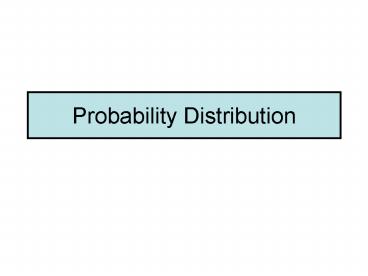Probability Distribution - PowerPoint PPT Presentation
1 / 9
Title:
Probability Distribution
Description:
Probability Distribution Probability Distributions: Overview To understand probability distributions, it is important to understand variables and random variables. – PowerPoint PPT presentation
Number of Views:278
Avg rating:3.0/5.0
Title: Probability Distribution
1
Probability Distribution
2
Probability Distributions OverviewTo understand
probability distributions, it is important to
understand variables and random variables.
- A variable is a symbol (A,B, x, y, etc.) that can
take on any of a specified set of values. - When the value of a variable is the outcome of a
statistical experiment, that variable is a random
variable.
3
An example will make this clear.
- Suppose you flip a coin two times.
- This simple statistical experiment can have four
possible outcomes HH, HT, TH, and TT. - Now, let the variable X represent the number of
Heads that result from this experiment. The
variable X can take on the values 0, 1, or 2. - In this example, X is a random variable because
its value is determined by the outcome of a
statistical experiment.
4
A probability distribution is a table or an
equation that links each outcome of a statistical
experiment with its probability of occurrence.
- Consider the coin flip experiment described
above. The table below, which associates each
outcome with its probability, is an example of a
probability distribution.
5
Probability distribution of the random variable
X.
x (Number of heads) 0 1 2
P(Xx) 0.25 0.5 0.25
6
Generally, statisticians use a capital letter to
represent a random variable and a lower-case
letter, to represent one of its values
- X represents the random variable X.
- P(X) represents the probability of X.
- P(X x) refers to the probability that the
random variable X is equal to a particular value,
denoted by x. As an example, P(X 1) refers to
the probability that the random variable X is
equal to 1.
7
Uniform Probability Distribution
- The simplest probability distribution occurs when
all of the values that a random variable can take
on occur with equal probability. - This probability distribution is called the
uniform distribution.
8
Examples
- When a fair die is tossed, the outcomes have an
equal probability. - When a fair coin is tossed, the outcomes have an
equal probability.
9
Discrete or continuous
- If a variable can take on any value between two
specified values, it is called a continuous
variable otherwise, it is called a discrete
variable.































